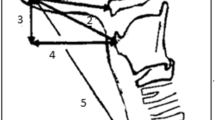Abstract
We investigated general and physical predictors of difficult laryngeal exposure in patients undergoing suspension laryngoscopy; 93 patients were included in this prospective study. The patients were classified as difficult laryngeal exposure group or non-difficult laryngeal exposure group based on the laryngeal view in suspension laryngoscopy. Twelve parameters (age, sex, body mass index, neck circumference, full mouth opening, modified mallampati index, hyoid-mental, thyroid-mental, horizontal thyroid-mental, vertical thyroid-mental, sternum-mental distance) that could predict difficult laryngeal exposure were evaluated. Of 93 patients, 22 had difficult laryngeal exposure. Cormack-Lehane score, neck circumference, body mass index, modified mallampati index, hyoid-mental, thyroid-mental, vertical thyroid-mental, and sternum-mental distance showed significant correlation with difficult laryngeal exposure. Based on the multivariate analysis, neck circumference superior to 40 cm, hyoid-mental and sternum-mental distance with respectively a value less than 6.05 and 13.9 cm were independently associated with difficult laryngeal exposure. Muscular neck, hyoid-mental and sterno-mental distance should be considered clinical predictors of difficult laryngeal exposure. Measurements of physical variables at full extension position of the neck are more useful and reliable predictors than neutral position for the risk of difficult laryngeal exposure.

Similar content being viewed by others
References
Hochman II, Zeitels SM, Heaton JT (1999) Analysis of the forces and position required for direct laryngoscopic exposure of the anterior vocal folds. Ann Otol Rhinol Laryngol 108:715–724
Weed DT, Courey MS, Ossoff RH (1994) Microlaryngoscopy in the difficult surgical exposure: a new microlaryngoscope. Otolaryngol Head Neck Surg 110:247–252
Hsiung MW, Pai L, Kang BH et al (2004) Clinical predictors of difficult laryngeal exposure. Laryngoscope 114:358–363. doi:10.1097/00005537-200402000-00033
Friedman M, Tanyeri H, La Rosa M et al (1999) Clinical predictors of obstructive slep apnea. Laryngoscope 109:1901–1907. doi:10.1097/00005537-199912000-00002
Crosby ET, Cooper RM, Douglas MJ et al (1998) The unanticipated difficult airway with recommendations for management. Can J Anaesth 45:757–776
Cormack RS, Lehane J (1984) Difficult tracheal intubation in obstetrics. Anaesthesia 39:1105–1111. doi:10.1111/j.1365-2044.1984.tb08932.x
Hiremath AS, Hillman DR, James AL et al (1998) Relationship between difficult tracheal intubation and obstructive sleep apnea. Br J Anaesth 80:606–611
Mallampati SR, Gatt SP, Gugino LD et al (1985) A clinical sign to predict difficult tracheal intubation: a prospective study. Can Anaesth Soc J 32:429–434
Merah NA, Wong DT, Ffoulkes-Crabbe DJ et al (2005) Modified Mallampati test, thyromental distance and inter-incisor gap are the best predictors of difficult laryngoscopy in West Africans. Can J Anaesth 52:291–296
Roh JL, Lee YW (2005) Prediction of difficult laryngeal exposure in patients undergoing microlaryngosurgery. Ann Otol Rhinol Laryngol 114:614–620
Toshiya S, Zen’ichiro W, Tetsuo I et al (2005) Predicting difficult intubation in apparently normal patients: a meta-analysis of bedside screening test performance. Anesthesiology 103:429–437. doi:10.1097/00000542-200508000-00027
Banjong K, Siriwan D, Sujarit K et al (2005) The predictive value of the height ratio and thyromental distance: four predictive tests for difficult laryngoscopy. Anesth Analg 101:1542–1545. doi:10.1213/01.ANE.0000181000.43971.1E
Kawaida M, Fukuda H, Kohno N (2001) Video-assisted rigid endoscopic laryngosurgery: application to cases with laryngeal exposure. J Voice 15:305–312. doi:10.1016/S0892-1997(01)00032-7
Kikkawa YS, Tsunoda K, Niimi S (2004) Prediction and surgical management of difficult laryngoscopy. Laryngoscope 114:76–78. doi:10.1097/00005537-200404000-00036
Tsunoda K, Kikkawa YS, Yoshihashi R et al (2002) Detachable forceps for flexible fibre-optic surgery: a new technique for phonosurgery in cases where rigid laryngoscopy is contraindicated. J Laryngol Otol 116:559–561
Zeitels SM, Vaughan CW (1994) ‘‘External counterpressure’’ and ‘‘internal distention’’ for optimal laryngoscopic exposure of the anterior glottal comissure. Ann Otol Rhinol Laryngol 103:669–675
Yeh AR, Huang HM, Chen YL (1999) Telescopic video microlaryngeal surgery. Ann Otol Rhinol Laryngol 108:165–168
Conflict of interest statement
All authors indicate that there is no conflict of interest or any financial relationship in this study. This manuscript is submitted to be considered for publication as an article in your journal. Neither the entire paper nor any part of its content has been published in another journal. All of the authors have read and approved this manuscript.
Author information
Authors and Affiliations
Corresponding author
Rights and permissions
About this article
Cite this article
Pinar, E., Calli, C., Oncel, S. et al. Preoperative clinical prediction of difficult laryngeal exposure in suspension laryngoscopy. Eur Arch Otorhinolaryngol 266, 699–703 (2009). https://doi.org/10.1007/s00405-008-0853-z
Received:
Accepted:
Published:
Issue Date:
DOI: https://doi.org/10.1007/s00405-008-0853-z




